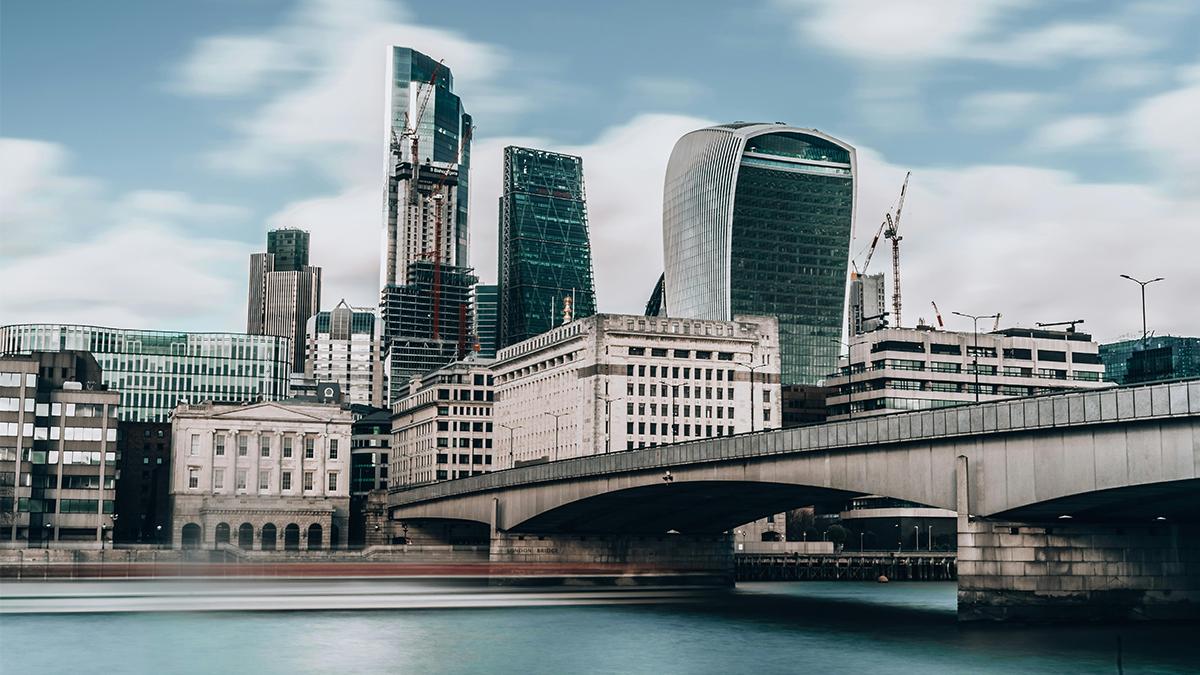When you’re in the City of London, it’s hard to miss the dazzling array of iconic buildings and skyscrapers. In fact, London is renowned for its ground breaking architecture. As a global centre of business, it has always needed to move with the times, combining the best new architecture and materials with the best of the old – creating buildings which have become instantly recognisable and famous across the world.
We’re going to take a look at some of these incredible buildings. We’ll check out a place that’s seen everything from plagues to pageantry, the tallest building in London and a very cool garden up in the air!
You might never have thought it, but just 50 years ago the idea of skyscrapers in London was quite unheard of. London’s built on clay that’s so much softer than the rocky ground of American cities like Manhattan. To give buildings stability, they need very deep foundations, which you can sometimes see when new construction is underway.
Broadgate Tower
Broadgate Tower doesn’t have conventional foundations! That’s because this 35 storey tower is on top of Liverpool Street station and the train tracks. Designed by Skidmore, Owing and Merrill, the building rests on a horizontal raft that spans the tracks. Because of this, it has to be light as a feather and was built using mainly steel and glass.
Broadgate Tower shares Broadgate Plaza with 201 Bishopsgate. The Plaza is a light-filled avenue with steel struts crisscrossing the glass façade give the buildings a rigorous, expressive quality.
Like quite a few buildings around London, it’s been in the movies, including James Bond Skyfall.
Broadgate Circle
Welcome to Broadgate Circle and 5 Broadgate. This 13-storey groundscaper was designed by Make Architects. It’s not only functional but an ambitious and visually innovative design, which is based on the form of a perfectly machined metal object, like an engine block. The main facade is primarily constructed from stainless steel – in fact, it’s one of the largest stainless steel-clad buildings in the world.
Now, you might not think it but there was a railway station here. It was called Broad Street and served what today is part of London Overground. The station was demolished in 1986 – making way for this amazing development – including Broadgate Circle.
Heron Tower
Let’s head to Heron Tower in Bishopsgate. Designed by KPF architects, this 46-storey building stretches a whopping 230 metres into the skyline.
It’s the tallest building in the city with 36 storeys of offices. If you’re feeling peckish, there’s a restaurant at the top. In the reception is a huge aquarium tank with over 1,200 fish.
The interior is organised around a series of office villages with a triple-height atrium at the heart of each and a slender lift core that’s animated by the movement of glazed lifts. Unlike older buildings in the city, this one is built with sustainability in mind – its highly transparent ventilated façade creates an energy-efficient enclosure.
100 Bishopsgate
Next door is 100 Bishopsgate. It’s more traditional in design, meaning it hasn’t got a well-known nickname based on its shape. That said, it’s affectionately referred to as the skyscraper with a skirt.
Can of Ham
Here’s a building that’s known as Can of Ham. It’s at 70 St Mary Axe.
This distinctive 24 storey building was designed by Foggo Associates Architects. Now, we all know how important it is to save resources, and this building features a number of energy-saving measures, including shading fins on the curved façades, glazed double-wall cladding and borehole thermal energy storage.
The building is arched, with two curved facades and flat ends creating the distinctive shape that resembles the shape of tins of ham, from which it gets its nickname – Can of Ham. The building is clad in glass with bronze coloured aluminium fins that run up the curved facades and wrap over the top of the building. At the top, the glass panels are replaced with a mesh that give the appearance of a continuing surface whilst hiding the cooling and heating equipment.
The building has a double-height entrance atrium, with a concrete reception desk at its centre. The reception walls are individually hand-poured, board-marked concrete panels.
The Gherkin
Welcome to 30 St Mary Axe – a building commonly known as The Gherkin. It’s instantly recognisable. Like many new buildings, its shape is in part designed to make the most of the available space, with a slimmer base that means more room for the public at the base.
Standing proud at 180 metres, the glittering glass structure is over three times the height of Nelson’s Column. From the top, you get 360 degree views of London.
Because of its smooth curves, it almost seems as if you could put your arms around it and take it home!
It was designed by Norman Foster, winning a RIBA Stirling prize for architecture.
It’s known as The Gherkin but its real name is 30 St Mary’s Axe. Do you know what that’s all about?
There used to be a church called St Mary here until demolished around 1560, and the axe, well they say it came from the axes used by the Worshipful Company of Skinners.
Whilst it’s modern, it has links with Roman times. During the Gherkin’s construction, they discovered the body of a Roman girl. She was given a funeral at St Botolph’s Church and was reburied under the Gherkin.
22 Bishopsgate
At 288 metres, 22 Bishopsgate is another of the city’s tallest buildings – and one with the deepest foundations at 65 metres… but it’s not all about offices.
The architects designed the building to improve the everyday experience for the public as well as the office workers, with art, craft, high ceilings and lots of fresh air. Its 23 sided, faceted glass body is shaped to respect the townscape views.
Did you know there are rules about what views new buildings mustn’t block, like views of St Pauls Cathedral or the Tower of London?!
Tower 42
Another interesting building to see here is Tower 42. It was London’s first skyscraper and for many years was the tallest building in the city and another where you can enjoy a bite to eat and take in the view from the top.
Tower 42 used to be called the NatWest Tower. It was built for the National Westminster Bank, hence its original name. At its centre is a massive concrete core, with the three leaves of each floor attached on a cantilever design. And double deckers aren’t just for buses, the lifts are doubledecked, stopping at two floors at a time!
Here’s a fun fact, when you look at it from above, you can see its design resembles the three-chevron logo of the NatWest bank.
The Leadenhall Building
Our next building is The Leadenhall Building, and its just on the other side of Undershaft.
As we found at 22 Bishopsgate, there are rules about how buildings are built in the city, some of which help protect views of famous landmarks and to maximise public space.
The distinctive tapering shape of this building, designed by Rogers Stirk Harbour and Partners, helps protect views of St Paul’s Cathedral.
Its rather strange triangular shape also led to it being nicknamed The Cheesegrater.
The Scalpel
We’re at 52 Lime Street, another building with an interesting nickname. If you look at the building from the corner of Lime Street and Leadenhall Street, you can see how it got its nickname of The Scalpel – it’s got a very distinctive angular design.
Cutting through the air, this skyscraper is 190 metres tall with 42 storeys. It’s an elegant building with reflective glass and bright metallic fold lines.
It leans away from Leadenhall so as to be invisible behind the dome of St Paul’s Cathedral when approached from Fleet Street – another example of the work that goes into preserving the view.
From the south of the Thames, people say it looks like a “play” media button. Can you spot the triangle shapes that might make people think this?
The Willis Building
The Willis Building was designed by Foster + Partners. It’s a striking 28 storey tower and its use of overlapping curved shells makes it look a bit like a fish tail.
It was designed to resemble the shell of a prawn, and as buildings go, this one is a bit of a bobby dazzler! It’s a glittering display of solid and glazed panels arranged in a saw-tooth pattern, with the fins helping insulate the building while also reducing the sun’s glare.
As well as creating a large tree-lined public plaza, the Willis Building has also gone above and beyond targets for ecological build, using sustainably sourced wood and green walls to create an energy-efficient building.
The Lloyd’s Building
The Lloyd’s Building was designed by Richard Rogers, it has what is called a modernist look. Revolutionary as it was, the Lloyd’s Building still succeeded in complementing the City’s existing architecture and is now a Grade I listed building.
It was considered a very high tech building when it was built. Like the Pompidou Centre in Paris, the designers used a technique whereby the bowels of the building (that’s things like ducts, cables, even the lifts) are on the outside giving it a futuristic, machine-like exterior.
The Lloyd’s Building became the youngest building ever to achieve Grade I listed status, making it truly a modern icon!
10 Fenchurch Street
Welcome to 10 Fenchurch Street. Now it might not reach the heights of some of its neighbours, but Eric Parry Architects’ 15-storey building is a definitely a distinctive addition to the City’s skyline.
166 white glazed terracotta fins encase the building. At the top you can see the crystalline glass ‘crown’ at the summit that changes appearance to reflect daylight and weather conditions.
The Walkie Talkie
At 20 Fenchurch Street is another building with a famous nickname! The Walkie Talkie!
This 155 metre high tower has more space at the top than down at street level.
Designed by architect, Raphael Viñoly, the chunky shape is known as the postmodern style although some think it’s a bit too chunky. It’s shape has also caused some issues.
The concave glass wall at the front occasionally acts as a lens for the sun’s rays and in one notorious incident, the sun’s reflection melted the paintwork on a car parked in the street below.
The Sky Garden is the highest public park in London with an outside roof terrace and a 360° panorama of London. A great place to relax after a long walk.
Here’s some other buildings you might like to check out:
- Watermark Place has the largest area of open riverside space in the City.
- Bloomberg Place has bronze blades that act as moveable solar shades and gills to fill the building with fresh air. It’s also home to the Roman Temple of Mithras.
- You can’t miss the Shard – named from its resemblance to a wedge of broken glass. It’s said the architect Enzo Piano sketched the shape on the back of a restaurant menu.
London’s History
London has a rich and full history that we can't wait to tell you all about! From The Romans of Londinium to the Tudors of London, it's all here.
More From London’s History







